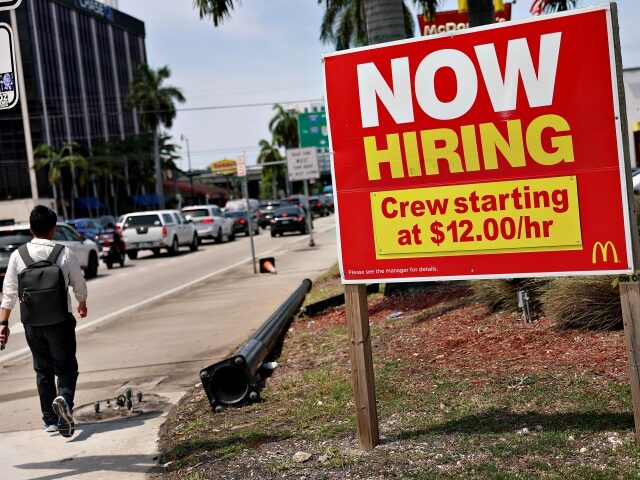Mass immigration makes finding “stable jobs with decent pay” harder for Americans, especially those in the working class, the New York Times admits.
In an analysis of the Labor Department’s latest jobs report, which showed that about 199,000 jobs were created in November, the New York Times suggested President Joe Biden’s policy to import as many foreign workers as the business lobby requests hurts Americans looking for high-paying jobs with good benefits.
“That influx of workers, which includes a recovery in immigration flows, has also taken the air out of wage increases and made it more difficult for people on the margins of the labor market to find stable jobs with decent pay,” the Times reports:
Joshua Robinson, 33, went to trade school for massage therapy and lives in Erie, Pa. But after a couple of occupational injuries, including a herniated disc in his lower back from working at a trampoline park, he is unable to do anything very physical. So he looked for work from July to October, applying for some 200 jobs before he landed a position as a technician at a compounding pharmacy that now pays $16 an hour. [Emphasis added]
“People are paying, like, a little better when it comes to wages, but it’s still not reaching a livable wage, or what I would call thrivable; it’s more like a subsistence level,” said Mr. Rosenthal, who lives with his mother to save money. “I know they say people are hiring, but I don’t really believe it.” [Emphasis added]
The admission was noted by Oren Cass, the nationalist-populist who heads American Compass. Days before the analysis, Cass had been interviewed by the Times.
In the interview, Cass mentioned that Republicans ought to embrace pro-labor policies such as cutting overall legal immigration levels, fierce enforcement of federal immigration law, and eliminating visa programs that import low-wage foreign workers to compete against Americans:
When we talk about a conservative embrace of labor, what we mean is an embrace of workers’ interests and an emphasis on enhancing worker power. The “labor” piece that conservatives don’t like is, generally speaking, the dysfunctional labor unions that characterize the American system of organized labor today and have become appendages of the Democratic Party rather than genuine representatives of workers’ economic interests. An obvious and concrete example of the distinction here is on the question of immigration policy. Strong immigration enforcement, reduction of immigration into low-wage segments of the labor market and the elimination of guest worker programs are “pro-labor” policies by any useful definition of the term, and ones that conservatives should endorse and increasingly are endorsing. They are also policies that “labor” as defined by progressive labor unions tend to oppose. [Emphasis added]
Beneath the remarks, the Times inserted “commentary” that suggested immigration has little-to-no impact on wages and the nation’s labor market, Cass wrote on Twitter. Days later, the Times published the analysis, which admits immigration is connected to wages and jobs.
Missing from the Times analysis is the number of working-age Americans who have dropped out of the labor market altogether as Biden imports a historic number of foreign workers to fill United States jobs.
Notably, Center for Immigration Studies Director of Research Steven Camarota estimates that more than 44 million native-born Americans remain on the labor market sidelines — not including the millions of native-born Americans counted in monthly unemployment figures.
“If we didn’t have access to all this immigrant labor, employers and the American people … would demand that we try to reinstill the value of work,” Camarota said.
He continued, “Raising wages would be one of the most important things to make work more attractive. Immigration lets us not do any of that, including the current flow of massive illegal immigration [Emphasis added].”
In particular, Camarota told Congress in 2023 that the working class is the most impacted by mass immigration. For American men 16 to 64 years old with only a high school degree, the labor force participation rate has dropped from 88 percent in 1960 to just 67 percent in 2023.
Even among prime-age working-class American men, 25 to 54 years old, the labor force participation rate has declined from near full employment in 1960, at 96 percent, to just 82 percent in 2023.
Annually, the U.S. gives green cards to about 1.2 million legal immigrants, while another 1.4 million foreign workers are admitted on visas to take American jobs.
At the same time, hundreds of thousands of illegal aliens are added to the labor market every year, many on work permits given to them by the federal government.
John Binder is a reporter for Breitbart News. Email him at jbinder@breitbart.com. Follow him on Twitter here.

COMMENTS
Please let us know if you're having issues with commenting.